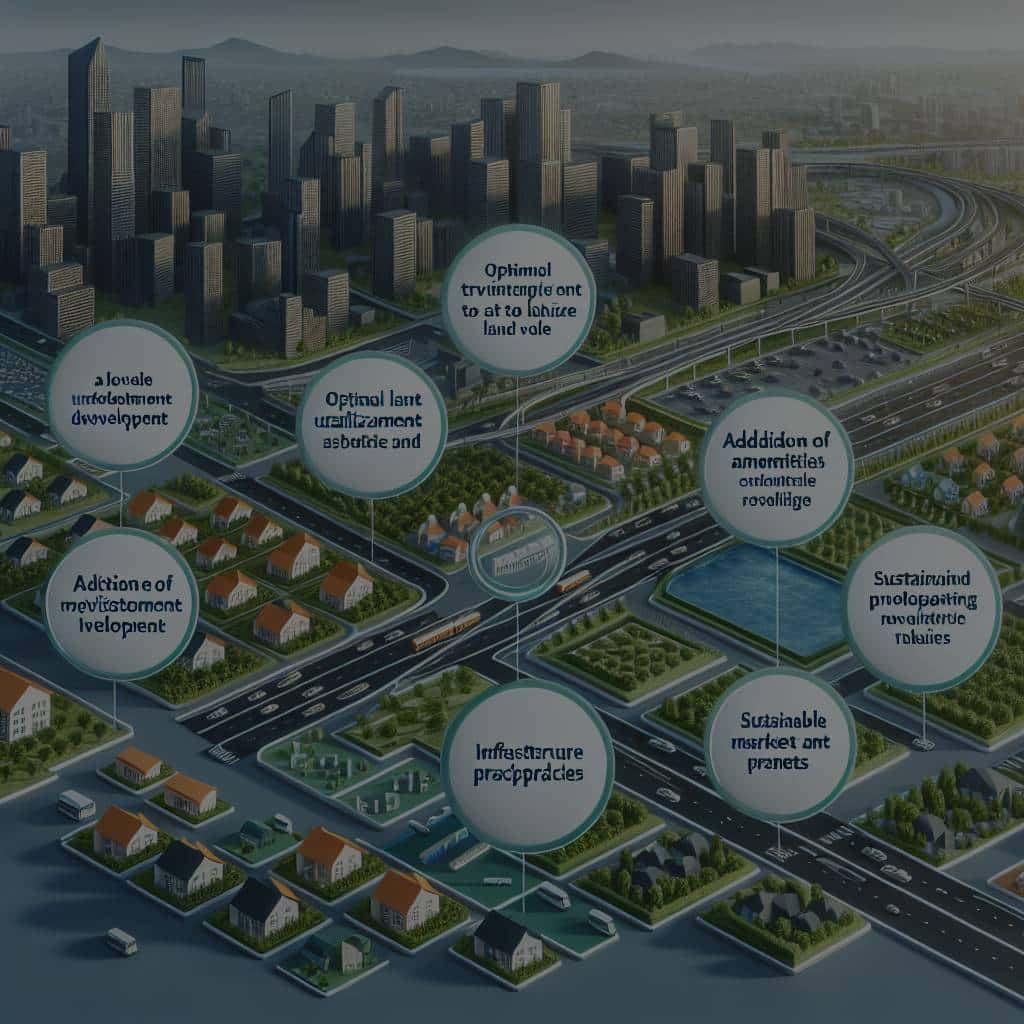What Strategies Can Help Maximize Land Value in Real Estate Development?

In the highly competitive world of real estate development, every decision made can significantly impact the overall value of the land you’re investing in. From the initial phase of selecting the right parcel of land to the final stage of selling or leasing the developed property, each step involves strategic decisions that affect the ultimate value of your investment.
Understanding the strategies that can help maximize land value is critical for your business’s success. In this article, we will explore various methods and approaches that can boost the value of your land and ensure a return on your investment.
A lire en complément : What Are the Considerations for Developing Real Estate in Tornado-Prone Areas?
Strategic Location Selection
The first and most crucial step in maximizing land value is selecting the right location. The area in which the land is located largely determines its initial value and how much it could potentially increase in the future.
When choosing a location, consider factors such as proximity to amenities, future development plans in the area, and economic trends. Areas undergoing regeneration or slated for future developments often offer excellent opportunities for capital growth.
Sujet a lire : How to Integrate Community Health Initiatives into Real Estate Development Projects?
Similarly, land located near amenities such as schools, shops, and transportation hubs typically holds higher value as these conveniences are attractive to prospective homebuyers and tenants. Studying market trends and economic indicators can also provide insight into areas that might experience growth in the future, offering potential for your land value to increase.
Effective Land Use Planning
Effective land use planning is another critical factor in maximizing land value. This involves determining the best possible use for a piece of land to ensure that it fulfills its maximum potential.
In land use planning, you should consider zoning laws, environmental factors, and the needs of the local community. For instance, if the land is situated in a residential area, developing it into residential properties will likely yield a higher return than commercial or industrial use. Moreover, incorporating sustainable building practices and green spaces can further boost the value of your land as this increases its appeal to potential buyers or tenants who are environmentally conscious.
Adding Infrastructure and Amenities
Adding infrastructure and amenities to your land can significantly increase its value. This includes developing access roads, installing utilities like water and electricity, and building amenities like parks, shopping centers, or schools.
These additions make the land more appealing to potential buyers or tenants, as they provide convenience and enhance the quality of life. Keep in mind that the cost of these improvements should be factored into your budget to ensure a positive return on investment.
Market Timing
The real estate market is often characterized by cycles of boom and bust. Timing your investment and development activities to coincide with these cycles can have a significant impact on land value.
During a boom, land values increase due to high demand and low supply. This is a good time to sell or lease your property. Conversely, during a market downturn, land values may decrease. This period is ideal for buying land as you can often get it at a lower price, with the anticipation of selling or leasing it during the next market upswing.
Legal and Tax Considerations
Legal and tax considerations can also influence the value of your land. For instance, land that has clear and uncontested title deeds is generally more valuable than land with disputed ownership. Additionally, tax incentives may be available for certain types of development or in specific regions, which can increase the profitability of your project.
In conclusion, several strategies can help maximize land value in real estate development. By choosing a strategic location, planning effective land use, adding infrastructure and amenities, timing the market, and considering legal and tax factors, you can enhance the value of your land and secure a significant return on your investment. Remember that each piece of land is unique, and the most effective strategy will depend on individual circumstances and market conditions.
Utilizing Highest and Best Use Analysis
One fundamental strategy in maximizing land value is to conduct a Highest and Best Use (HBU) analysis. This is a concept in real estate appraisal that determines the most financially feasible and physically possible use of a property that would generate the highest value.
The HBU analysis considers the property’s current use and compares it with all potential alternate uses. The evaluation process is often a careful balance of four factors: physically possible, legally permissible, financially feasible, and maximally productive. In other words, the proposed use must be physically possible considering the size, shape, and location of the land, legally permissible under current zoning and land use regulations, financially feasible providing a return on investment, and be the most profitable among all alternative feasible uses.
Conducting an HBU analysis is essential because real estate development is not just about maximizing the use of the land but maximizing its value. This is particularly true for underutilized lands, where current use doesn’t align with the property’s maximum potential. A rigorous HBU analysis can reveal opportunities to create value that were previously overlooked.
Leveraging Technological Advancements
In the age of digital transformation, leveraging technological advancements can also contribute to maximizing land value. In particular, Geographic Information Systems (GIS) and Building Information Modelling (BIM) have become increasingly significant in the real estate development industry.
GIS is a powerful tool that can analyze and display geographical data, helping developers to understand the physical characteristics of a parcel of land, the environmental constraints, and the demographic and socioeconomic conditions of the surrounding area. This information can guide developers in making informed decisions about the type and scale of development that would be most appropriate and valuable.
On the other hand, BIM is a 3D model-based process that gives architecture, engineering, and construction professionals insights to more efficiently plan, design, construct, and manage buildings and infrastructure. By using BIM, developers can optimize the design and construction process, reduce costs, and enhance the value and appeal of the built environment, thereby maximizing the value of the land.
Conclusion
Maximizing land value is a multi-faceted process that goes beyond just choosing a strategic location and adding infrastructure and amenities. It requires a deep understanding of the real estate market, legal and tax considerations, and the specific characteristics and potential of the land. Moreover, it involves strategic decision-making and planning, from conducting a rigorous Highest and Best Use analysis to leveraging technological advancements such as GIS and BIM. As a real estate developer, understanding and applying these strategies can significantly boost the value of your property and ensure a substantial return on your investment. The real key, however, lies in aligning these strategies with the unique circumstances and market conditions of each development project.
